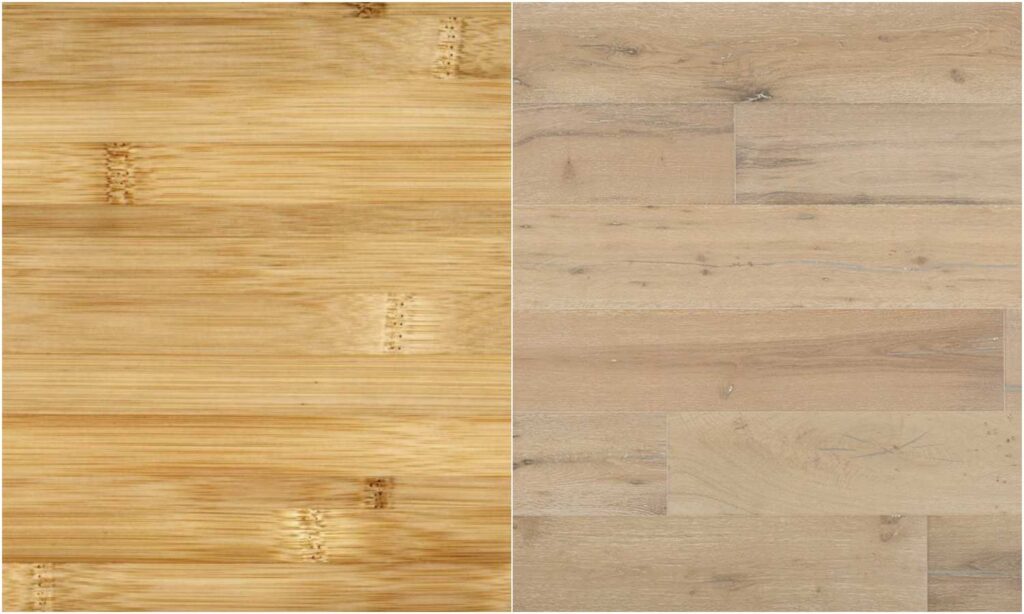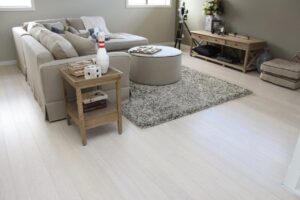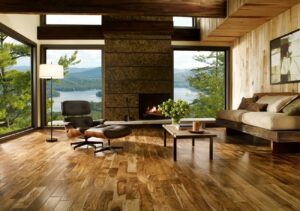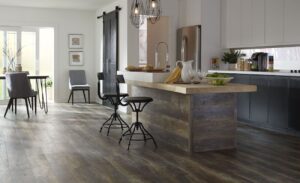So you are looking for Bamboo Vs Wood Flooring Review, here is the right path to start with.
At the first sight, you may constantly misunderstand bamboo and wood since they come with nearly the same characteristics.
In fact, both bamboo and wood flooring are frequently categorized into “Solid-hardwood” flooring.
Typically, either solid bamboo or wood flooring materials are constructed into ¾ inch-thick solid planks while the engineered version comes with the finish-quality natural veneer to laminate the top layers.
Though the similarities do exist, a few key differences are also there to recognize.
Thus, we write this article to completely compare bamboo flooring to wood flooring side-by-side which include the general description of bamboo and wood, the general characteristics, the appearance of both flooring types, their price, environmental comparison, moisture issues, quality control and refinishing of the both flooring.
Now let’s check them all out in the review sections below:
General Description Of Bamboo and Wood Flooring
A big fact you have to underline from all the description is that bamboo and wood is different.
Bamboo is a woody grass, it is not a wood. Bamboo grows in tropical parts of the world where heavy rainfalls are falling down to earth much.
Bamboo grow faster than the wood, allowing the farmer to harvest earlier, too.
If you think that bamboo is resistant to water, you are totally wrong.
Bamboo can even get damaged by the water flow or water spill.
Typically, harvesting mature bamboo needs three to five years after the plantation.
In the other words, bamboo needs three to five years to reach the maturity so that it can be the good materials for flooring construction.
Read Also: Brazilian Walnut Flooring – The Most Durable Flooring To Consider
General Characteristics of Bamboo and Wood Flooring
The next bamboo Vs wood flooring review to look at is the general characteristics of the two flooring types.
In general, bamboo is considered harder than the hardwood.
Just because the hardwood has a name “hard”wood doesn’t mean that it is extremely hard from the beginning to the end.
In fact, the name “hardwood” is originated from the trees in which the wood is cut down and take away to the flooring manufacturer.
The trees include the conifer trees along with the seed cones.
The group of hardwoods popularly introduce maple, oak, cherry, walnut and hickory as the flooring types variants.
In the world of flooring, hardwood is always harder than the softwood.
The hardness of a flooring product is commonly measured by a test known as “Janka Hardness Test”.
The test is carried out by pressing down a steel ball into the wood.
Later, it is measure how deep the ball dents the wood.
According to Janka Hardness test, some hardwood types are softer than the softwood and some other are even softer than the bamboo.
According to Janka Hardness test, red walnut and Brazilian oak teak has 2,500 to 3,500 ratings, hard maple has 1,450 ratings, red oak has 1,220 ratings, cherry has 950 ratings, poplar has 540 ratings and aspen has 350 ratings.
In this case, the softwood can be harder than the hardwood such as Eastern and Cedar which has 900 ratings and Douglas Fir which has 660 ratings.
In fact, bamboo is a natural material with Janka Hardness rating of 1300 to 1400.
These ratings are much higher than the most oak flooring.
The carbonized bamboo which is created through the pressing down involving heat and pressure to darken the bamboo color.
This makes the carbonized bamboo has Janka Ratings 1,000 to 1,100 ratings only.
However, this rating is considered harder than the hardwood.
The Appearance of Bamboo and Wood Flooring
Now let’s go to a bamboo Vs wood flooring review particularly on the bamboo and wood appearance.
Truly, hardwood comes with a large variety of species to choose from.
Each species has its own unique and distinctive feel, look and pattern.
Hardwood also comes in many different grades due to the wide range of pieces resulted from the different cuts.
This allow you to choose any of the hardwood types with the most desired look of your own.
Surely, hardwood comes in a big number of species and options offering you the perfect matches of style to meet your personal choice and environment as well.
On the other hand, bamboo has only a little diversity, meaning that it has a narrower option.
Based on its construction, there are three types of bamboo flooring that are flat grain, vertical grain and stranded bamboo.
The flat grain is designed with the bamboo thin and flat layers that are glued down together to create planks.
The vertical grain has a narrower strip, presenting the strip appearance.
And the third bamboo type which is the stranded bamboo is constructed from the bamboo fibers glued down using resin.
Prices Comparisons
There are two kinds of price we are going to share you in this article today.
Those are the material price and the installation price. Thus, you will have a picture of complete price to predict.
In this regards, the price of bamboo and hardwood flooring is quite comparable and competitive.
Standard material of hardwoods such as maple and red oak costs around $4 to $8 per square foot while the uncommon hardwood type costs $10 per square foot.
Bamboo flooring comes with the costs $3.80 per square foot along with the price options of $2 to $5 per square foot.
However, you can have more or less cheaper materials depending on the quality of the materials.
For the installation costs, bamboo and hardwood installation costs are also comparable.
The professional installation of bamboo and hardwood flooring ranges from $4 to $8 per square foot.
This installation costs are much depending on the labor cost, where you are and how difficult or easy the installation would be.
In short, either materials or installation price offered by bamboo and hardwood flooring is all comparable.
Environmental Comparisons
The next bamboo Vs wood flooring review to discuss here is the environmental comparisons.
Noticeably, bamboo offers eco-friendly building materials due to the fact that bamboo grows fast within three to five years to harvest.
In addition, the farmers cut down the bamboo trees without the roots, letting bamboo grows again from the roots. Thus, replanting is not necessary.
Further, bamboo is a natural plant, meaning that it is recyclable as well as biodegradable.
However, some environmental issues arise, too, out of the bamboo flooring.
Bamboo tress are grown in Southeast Asia and transported to any other parts around the globe.
This let the vehicles transporting the bamboo give out their gas emission of carbon in a greater amount. This is a real environmental issue.
In addition, some bamboo flooring types use adhesive which contains an unhealthy substance for human and pet.
Different from bamboo, hardwood tree needs 20 years and even more to get matured and ready for the manufacturing.
And harvesting means killing the woods completely. Thus, replanting is a must to generate the wood for years to come.
Due to the fact that wood can grow anywhere else around the world, the transportation costs are not as higher as the bamboo’s.
In fact, solid hardwood is purely wood. There is no chemical substance or glue used except for engineered wood.
Moisture Issues
In the world of flooring, either bamboo or wood, moisture issues are not the uncommon things to know.
Standing water and even water vapor can cause damage not only for bamboo but also wood flooring.
Discoloration is the final result that your floors may experience because of the moisture existence, particularly if you do not care for the floors properly.
In this case, neither bamboo nor wood is recommended to install on below-grades applications.
Both of these flooring materials are susceptible especially if they are not added by the proper finish.
Quality Control
Noticeably, hardwood flooring materials are rated better than the bamboo for its size, shape, evenness, color consistency, moisture content and pattern features.
On the other hand, bamboo is not recently rated officially due to the fact that it is new in flooring.
Thus, you are not able to know the exact quality of bamboo flooring materials.
The best way to work with is to find the reputable home improvement stores to purchase the best quality bamboo flooring products.
Refinishing of Bamboo and Wood Flooring
The last bamboo Vs wood flooring review is about refinish.
This way, both bamboo and wood flooring can be refinished and sanded when they scratch and dent.
How many times you can refinish and san the floor will much depend on the thickness of the flooring products.
Shortly, bamboo and wood are comparable enough in refinishing and sanding.
Read Also: Bamboo Flooring Ideas Mix and Match Designs with Pictures
Final Words
Finally, you have completely known the bamboo Vs wood flooring review.
Hopefully, you can make the best decision whether on choosing bamboo or wood.
However, your decision will commonly lay on what you need and what you want toward your flooring projects.





